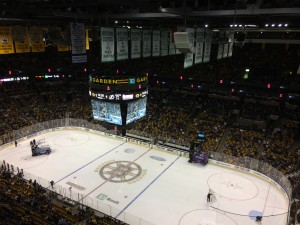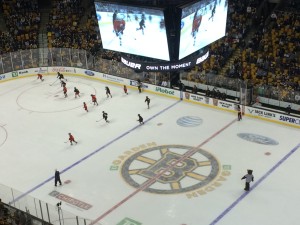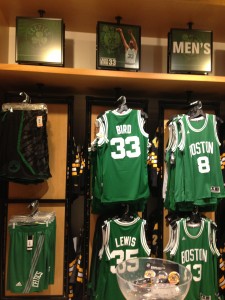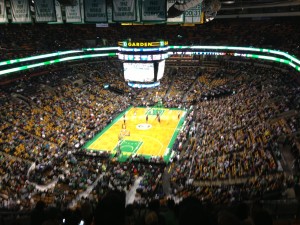About a week ago, I came home from a good visit in Boston planned due to an inspirational collaboration with Professor Stephen Greyser from Harvard Business School. In his book The Business of Sports, Stephen deals with a holistic approach in terms of analyzing the vitality and omnipresence of sports fans and how these fans shape and/or influence business models in sports. During my visit, Stephen and I had numerous dialogues and discussions about the importance of fan engagement for sports properties and how to build monetizing relationships with fans. Moreover, I had the pleasure to visit Boston Celtics and Boston Bruins to get a first-hand impression of their fan relationship tactics.
In my work within the business of sports, I have experienced the commercialization differences in sports across international borders. In that sense, I have also come to understand that I fully agree with Stephen’s notion that fans act as the primary resource when one is looking to capitalize on the business of sports. Consequently, fans are interactive in nature and therefore influence (or should be considered) at any level of a business model in sports whether focus is on the league’s, team’s or athlete’s business development and profit maximization or goes in the direction of event facilitation, media production, sponsorship integration, merchandise sales or venue experience optimization. If the sports property (and its related business partners) succeeds in getting fans to devote their time, money and passion to the consumption of its products, services and experiences then there is a sound potential to produce profitable economic and emotional impact.
From my Danish perspective, I witnessed this process when I went to TD Garden to watch NBA basketball (Boston Celtics vs. New Orleans Pelicans) and NHL hockey (Boston Bruins vs. Tampa Bay Lightning). In the light of an intercultural comparison (comparing to sports events in Denmark), the teams in Boston did extremely well in terms of staging entertaining sports experiences capable of engaging fans in the venue at all times. The sports product is good on the playing field (NBA and NHL are strong leagues) but so is the way of engaging fans outside the game in motion.
Some examples taken from the Boston Bruins include that fans got to ride the Zamboni machine (ice resurfacer), that a good deal of match-stats were available, and that the team did show great utilization of the Jumbotron for players’ interviews during breaks or for great hits (an essential part of the NHL’s cultural DNA) from previous games, and that youth players got a chance to shine in a game that gave them ‘3 minutes of fame’. Moreover, Boston Bruins applied the Jumbotron when emphasizing the importance of ‘future Bruins’, i.e. highlights from games in which young players competed during a talent camp. That is a good way of highlighting the performances of young talents in the venue and that builds emotional equity. Overall, I found that the team is very transparent in giving fans a chance to get to know the players at a deeper level via the New England Sports Network (NESN), which is owned by the Boston Bruins and the Boston Red Sox and hence supplied to more than 4 million homes (NESN, 2015). NESN is integrated with the Boston Bruins official website, which in collaboration with NESN offers fans the opportunity to go behind the scenes of the daily lives of the players with access to the locker room, the executive board room, players’ homes and to reveal who is the best-dressed player on the team to provide an exceptional look into the inner processes of the fans’ favorite hockey organization (Boston Bruins, 2015).
Attempting to build fan engagement is a product of a sports property’s performance on and off the playing field. The engagement levels are boosted when the sports property finds a powerful formula to enhance the occurrence, length and concentration of the loyalty of fans’ time, passion and money. A modest tactic, which is popular among postmodern sports fans, is when teams like the Boston Bruins show selected Twitter and Facebook messages from fans on the Jumbotron as part of the game-day experience. That is a simple tactic to activate fans to engage in creative ways, e.g. worst-dressed fans, birthday messages, cheering fans, games faces etc. The team also tries to engage fans in the ‘show us your Bruins wild side’ presentation in which participants enter via Facebook or www.bruins.com; the behavior of fans is presented on the Jumbotron guided through a camera in the venue. The Jumbotron plays a central role in the venue experience and also displays old Bruins’ stars at the game and videos of legendary plays and team performances to constantly retain a strong emotional attachment to the team among all generations of fans.
Pictures: Boston Bruins vs. Tampa Bay Lightning (source: own photos).
Check out this Bruins video: IMG_3515
It is noteworthy how the overall venue experience is so good from my point of view when many Americans would probably say that it is generic for the NBA and the NHL. The amount of concession stands offer the ordinary sports variety of beers, sodas, burgers and hot dogs but also distinctive localized offerings like lobster rolls in Boston and compared to many European sports venue experiences the amount of concession stands is good. However, American sports fans take these venue experiences for granted; for that reason TD Garden initiated a $70 mio. renovation process in 2014, which is projected to be complete in 2015. The upgrade of the venue (phase 1 is already complete) includes modern concourses and updated concession offerings, a redesigned retail Pro-Shop and enhanced technology infrastructure to lift digital fan experiences (digital signage boards and high-density Wi-Fi). With this in mind, there is no doubt that sports consumption is massive in the US. There were lots fans wearing Boston Bruins jerseys in the venue that cost approximately $150 and drinking $8.5 beers. In that regard, it is interesting for me to conclude that there are no shirt sponsors on the shirts of the Bruins. I know that the jerseys are important to the American audience and that fans protested when the NBA proposed to place corporate sponsorship logos on the jerseys but this holds good revenue potential for the NHL that ranks fourth among the major leagues when measured on revenues. In Europe, teams change the sponsor of the jersey or the edition of the jersey to generate more revenues and that is one difference in revenue generation among European and American professional sports teams. My experiences also reveal that Americans to a higher extent than Danes (and many Europeans) come and drink and eat because they are at a game, i.e. it is a social thing and at the game the Americans obtain an escapist experience and can talk to strangers without feeling awkward. Fans in the US are insane about their sports idols to the same degree that soccer fans are in Europe. Fans yell and change their personality and live out the feeling that ‘we pay for our seats so we can say whatever we want’ and thus often engage in behavior that you would not see in people’s living rooms.
Basically, the “circles of fandom” as revealed by Stephen Greyser in his book portray that the enthusiastic consumer elements to sports start at an early age and it never stops. Sport is heavily articulated and fans are paying to engage; this is highly promoted by sports teams because professional athletes have high salaries. In that way, professional American sports leagues and teams are well cultivated in staging engaging fan experiences and if there is no perimeter space the leagues and teams will come up with new revenue sources. That mindset is an incorporated part of the business model.
Another thing that I learned when visiting Boston was that the teams are excellent at displaying ‘localized content’ to build emotional equity. This sense of pride characterized what both teams did but was most evident during the Boston Celtics’ pre-game show on the Jumbotron in which the team presented a Boston Celtics integrated ‘Boston video’. Likewise, Boston Celtics did well in terms of activating rows in the venue via a specific lottery that kept the fans moving. The team also threw different competitions like ‘fan of the game’ and involved and fostered fans via habitual game processes like ‘let’s make some noise’, cheering for the ‘defense’ when opponents were attacking or by use of the ‘kiss cam’. Additionally, the game experiences featured ‘meet & greet sessions’, an active mascot, an active camera among fans in the venue to make them engage in a wide variety of creative fan moments on the Jumbotron and a fine selection of fan competitions. The team also integrated the legacy of former greats like Larry Bird and the ‘champions signs’ that can be seen in any American sports venue. The incorporation of ‘hero production’ is something that the American sports franchises master and the Celtics gave tribute to a chosen ‘hero among us’ to underscore the value of community service (another example of emotional content that is redistributed through the chosen hero’s network). Sponsorship integration took place in an effort to link up with fan engagement when the team launched the Xfinity parachute drop that gave merchandise to the fans that caught the parachute that was dropped from the venue’s highest level. The importance of community outreach was reinforced when introducing the ‘soldier spotlight’ in which other heroes were recognized for their services.
Pictures: Boston Celtics vs. New Orleans Pelicans (source: own photos).
Check out this video: IMG_2500
Noting that Stephen Greyser has been a season ticket holder of the Boston Celtics for +45 years, he has an expert understanding of how the team deals with fan experiences. In analyzing the Celtics fan experience, he mentions “the evolution from very little fan engagement except for the one most important thing, namely the team performance on the court” to the development process over time, in which the Celtics fan experience “has become much more oriented to younger fans”. What the Celtics offered in the ‘old glory days’ (no team in the league has won more championships than the Celtics) was mainly team performance on the court and music. However, the musical entertainment was nothing like the high art of one of the great benchmarking examples in professional basketball like the famous Laker girls (a cheerleading team associated with the NBA’s Los Angeles Lakers). However, the Laker girls were made famous by the fact that Lakers were winners and that reflects the ever-important fact in professional sports that winning matters. Stephen emphasizes that the team has moved towards offering fans “a high quotient of entertainment” and that goes for the entire culture of the American league system in professional sports.
Video: an example of an event with activation of the Laker Girls.
Video: Boston Celtics dancers.
There is a culture of using intelligent peripheral services to wrap in the core sports product and Stephen adds, “fan engagement is primarily through entertainment and through the use of giant message boards (i.e. Jumbotrons)”. The Jumbotron is also used for replays. In that regard, Tony Verna deserves credit for inventing ‘instant replays’ for television and hence made one of the most significant contributions to the enjoyment of professional sports ( or of any sport) and to the value of the television in sports. The use of the Jumbotron is now used to include replays at all times or to lead fans into cheering (e.g. louder and louder, defense etc.). Nonetheless, Stephen and I still believe that the best way to get the crowd to make some noise is the performance on the court or on the ice (not telling them to get loud) although these tools make perfect sense in the era of postmodern sports consumption. Mentioning noise, the Seattle Seahawks of the NFL is very good at using their fans for noise. When games are in Seattle, the noise factor is a big help to the home team that exploits the noise factor by stirring up the crowd and having them make a lot of noise when the other team has the ball to make it difficult for the other team’s quarterback to call signals etc. This is a unique factor associated to Seattle Seahawks.
Video: How noise makes a difference for the Seattle Seahawks and plays a central role in the Seattle fan experience.
Stephen Greyser also created and still teaches the course ‘The Business of Sports’ (3-credit course) at Harvard so he constantly deals with vital aspects of business models in sports. When asked about some insightful examples of fan engagement experiences in sports, Stephen brings up the NFL and states “the NFL has done a very good job of attempting to make the experience of the stadium in regards of elements like entertainment, game insights and so on at least as good as television does at home.” He refers to the fact that the NFL has worked to make the game statistics (that television provides) available to fans through the WiFi systems at the stadium, especially to fans at the high priced seats (replays, statistics and other stuff that television provides). A good example of this is the new Levi’s Stadium, home of the San Francisco 49ers. Due to competent strategic partnership with leading technology providers, the venue displays great ‘stadium innovation’ and provides fans with stadium-wide WiFi coverage, media streaming services via mobile connectivity and IPTV and gigantic HD video boards to make sure that fans will not miss the action. The NFL has been smart in leveraging good fan experiences via new technologies, which is exemplified via the integration of stadium app solutions that offer access to NFL Red Zone[1] and real-time stats and game information from the press box while being tied in with the fans’ favorite team and player brands on various social media platforms.
Video: San Francisco 49ers pre-game event Red Zone Rally food & beverage and activation experience.
In the US, the major leagues have been strong in providing content to media companies but with technological devices such as as Ipads, cell phones etc. the leagues provide a digital alternative to what is going on in the venue as fans may be able to watch their own replays and so on. It is important to raise the question of what this does to the in-venue experience and Stephen believes that “the digital capabilities provide supplemental insight to fans in terms of in-venue opportunities”. Nothing beats the live-experience concerning game atmosphere and the digital capabilities provide opportunities to enjoy additional aspects of the game at the venue and thus to enhance the overall experience.
When linking fan relationships to revenue generation, Stephen mentions the Montreal Canadiens as a marquee example of how to build the bridge as “the Montreal Canadiens pioneered in providing a fan satisfaction experience beyond entertainment” in the form of an opportunity from your seat for purchasing food, beverages etc. This option is tied in with the brand integration and exhibits an added fan experience, which Stephen calls “beyond the normal entertainment and way beyond the performance of the team on the court or on the ice”. The Montreal Canadiens has paid attention to the function of mobile and digital devices in delivering enhanced game entertainment in sports by introducing this innovative solution that gives fans the opportunity to mix the need for game highlights and statistics, in-venue merchandise ordering and food and drinks from the comfortable position of the seat while being able to locate and interact with friends in the arena through the integration of social media. This provides fans with an exclusive experience that may be a good selling point in terms of creating loyalty meant to bring them back into the venue and given the interactive nature of the solution it offers the team to opportunity to push commercial messages and thus to lift this fan service in collaboration with more sponsors. There is no doubt that these services are stressing the importance of professional sports organizations offering relevant fan value on top of what takes place on the playing field.
Video: Montreal Canadiens and the Boston Bruins exploit mobile technologies.
All these examples provide evidence of the importance of the fact that what takes place on the playing field must be complemented by promotional activities and events facilitated by the commercial stakeholders of the sports property to inspire future fan engagement.
[1] The NFL Red Zone presents plays inside the red zone (the area of the field between the 20-yard line and the goal line) but in contrast to television it airs no advertising messages and goes the extra mile to illustrate big impact plays as they occur.




This is a great blog, Kenneth. Would love to pick your brain on your PHD research
Thank you Bas, my e-mail is kennethcortsen@hotmail.com and my cell number should be listed on the site 🙂